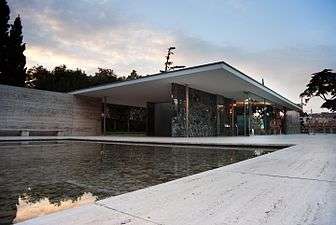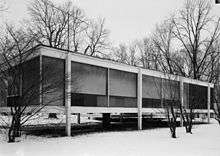Toronto-Dominion Centre
| Toronto-Dominion Centre | |
|---|---|
 | |
| General information | |
| Type | Commercial offices |
| Location | King and Bay Street |
| Town or city | Toronto |
| Country | Canada |
| Coordinates | 43°38′52″N 79°22′51″W / 43.6479°N 79.3808°WCoordinates: 43°38′52″N 79°22′51″W / 43.6479°N 79.3808°W |
| Construction started | 1964 |
| Completed | 1969 |
| Owner | Cadillac Fairview |
| Management | Cadillac Fairview |
| Height | |
| Antenna spire | None |
| Roof | 47 to 223 m (154 to 732 ft) |
| Top floor | 56 |
| Technical details | |
| Floor count | 22 to 56 |
| Lifts/elevators | TD Bank 32 and 2 freight; TD North 24 and 2 freight; TD West 10 and 2 freight; TD South 16 and 1 freight; Ernst and Young 32 and 1 freight; 95 Wellington 8 |
| Design and construction | |
| Architect | Ludwig Mies van der Rohe, John B. Parkin and Associates, Bregman + Hamann Architects |
| Developer |
Cadillac Fairview Toronto Dominion Bank |
| Main contractor | Pigott Construction |
| References | |
| Designated | 2003 |
The Toronto-Dominion Centre, or TD Centre, is a cluster of buildings in downtown Toronto, Ontario, owned by Cadillac Fairview. It has six towers and a pavilion covered in bronze-tinted glass and black painted steel. It serves as the global headquarters of the Toronto-Dominion Bank, and provides office and retail space for many other businesses. About 21,000 people work in the complex, making it the largest in Canada.
The project was the inspiration of Allen Lambert, former President and Chairman of the Board of the Toronto-Dominion Bank. Phyllis Lambert recommendes Ludwig Mies van der Rohe as design consultant to the architects, John B. Parkin and Associates and Bregman + Hamann,[4] and the Fairview Corporation as the developer.[5] The towers were completed between 1967 and 1991. An additional building was built outside the campus and purchased in 1998. Part of the complex, described by Philip Johnson as "the largest Mies in the world",[6] was designated under the Ontario Heritage Act in 2003 and received an Ontario Heritage Trust plaque in 2005.[7]
Design
As Ludwig Mies van der Rohe was given "virtually a free hand to create Toronto-Dominion Centre",[8] the complex, as a whole and in its details, is a classic example of his unique take on the International style[9] and represents the end the evolution of Mies's North American period, which began with his 1957 Seagram Building in New York City.[10]
Site and governing order
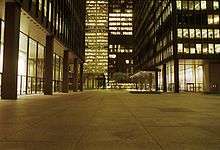

As with the Seagram Building and a number of Mies's subsequent projects, the Toronto-Dominion Centre follows the theme of the darkly coloured, rigidly ordered, steel and glass edifice set in an open plaza, itself surrounded by a dense and erratic, pre-existing urban fabric. The TD Centre, however, comprises a collection of structures spread across a granite plinth, all regulated in three dimensions and from the largest scale to the smallest, by a mathematically ordered, 1.5 m2 (16 sq ft) grid.[11]
Three structures were conceived: a low banking pavilion anchoring the site at the corner of King and Bay Streets, the main tower in the centre of the site, and another tower in the northwest corner, each structure offset to the adjacent by one bay of the governing grid, allowing views to "slide" open or closed as an observer moves across the court. The rectilinear pattern of Saint-Jean granite pavers follows the grid, serving to organize and unify the complex, and the plaza's surface material extends through the glass lobbies of the towers and the banking pavilion, blurring the distinction between interior and exterior space. The remaining voids between the buildings create space for a formal plaza to the north (later named Oscar Peterson Square in 2004), containing Al McWilliam's Bronze Arc, and an expanse of lawn to the south, featuring Joe Fafard's sculpture The Pasture;[12] these were the first examples of privately provided large-scale public outdoor spaces within the urban core of Toronto.
Phyllis Lambert wrote of the centre and the arrangement of its elements within the site:
With the Toronto-Dominion Centre, Mies realized an architecture of movement, and yet at the same time, through proportional relations among parts and whole, and through the restrained use of fine materials, this is also an architecture of repose. The light as it moves across the building surfaces, playing the mullions like stringed instruments, and the orchestration of the various buildings are together paradigmatically symphonic.[13]
More towers were added over the ensuing decades, outside the periphery of the original site—as they were not part of Mies's master plan for the TD Centre—but still positioned close enough, and in such locations, as to visually impact the sense of space within areas of the centre, forming Miesian western and southern walls to the lawn and a tall eastern flank to the plaza.
Towers
The height of each of Mies's two towers is proportioned to its width and depth,[11] though they, as well as those based on his style, are of different heights. All, save for 95 Wellington Street West, are of a similar construction and appearance: the frame is of structural steel, including the core (containing elevators, stairs, washrooms, and other service spaces), and floor plates are of concrete poured on steel deck. The lobby is a double height space on the ground floor, articulated by large sheets of plate glass held back from the exterior column line, providing for an overhang around the perimeter of the building, behind which the travertine-clad elevator cores are the only elements to touch the ground plane. Above the lobby, the building envelope is curtain wall made of bronze coloured glass in a matte-black painted steel frame, with exposed I-sections attached to the vertical mullions and structural columns;[5] the modules of this curtain wall are 1.5 m (4.9 ft) by 2.7 m (8.9 ft), thereby conforming to the overall site template.
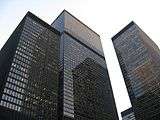 Three of the Toronto-Dominion Centre's towers: (left to right) the Ernst & Young Tower, TD Bank Tower, and TD North Tower
Three of the Toronto-Dominion Centre's towers: (left to right) the Ernst & Young Tower, TD Bank Tower, and TD North Tower- The south edge of the TD Centre, showing the TD Bank Building (right) and TD West Tower (left)
 The 1937 former Toronto Stock Exchange building nested within the base of the 1992 Ernst & Young Tower
The 1937 former Toronto Stock Exchange building nested within the base of the 1992 Ernst & Young Tower
On the topmost accessible floor of the Toronto-Dominion Bank Tower was a large indoor observation platform. As the tower was, when completed, the tallest in the city, this promontory once allowed uninterrupted views of the then quickly developing downtown core and of Lake Ontario to the south. This floor has since been converted to leased office space. On the level below is a restaurant on the south side and the Toronto-Dominion Bank corporate offices and boardroom are on the north. The interiors of the latter spaces were also designed by Mies and included his signature broad planes of rich, unadorned wood panelling, freestanding cabinets as partitions, wood slab desks, and some of his furniture pieces, such as the Barcelona chair, Barcelona ottoman, and Brno chair. Adjacent to the main boardroom at the northeast corner of the floor plate and the Thompson Room at the northwest corner, service areas are concealed within the wood panelled walls behind secret panels.
The Ernst & Young Tower contains in its base the former Toronto Stock Exchange building, built in 1937. The new edifice deviates from the strict Miesian aesthetic of all the previous towers to accommodate the Art Deco facade of the older building within its own. The Ernst and Young Tower is linked to the Toronto-Dominion Bank Tower at the ground floor and by a two-level pedestrian bridge at the sixth and seventh floors, and by the underground shopping concourse.
Pavilion and shopping concourse
The banking pavilion is a double-height structure housing the main branch of the bank. It contains fifteen 22.9 m2 (246 sq ft) modules within a single interior space,[11] with smaller areas inside the pavilion cordoned off using counters and cabinets, all built with the typical rich materials of Mies's palette—marble, English oak, and granite.[10] The roof of the building is made of deep steel I-sections, each beam supported on only one steel I-section column at each end, all combined to create a waffle-grid ceiling resting on a row of corresponding, equally spaced columns around the periphery. This structure was both a further development on the post office pavilion of the Federal Center in Chicago—which has less expressed columns and a second level balcony—and a precursor to the Neue Nationalgalerie completed in Berlin in 1968—which had a similar roof supported on only eight large steel columns. The TD Centre pavilion was described by The Globe and Mail as "among the best spaces Mies ever made".[14]
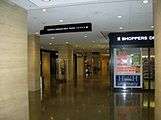 A view of the underground concourse, with the black aluminum signs mandated by Mies
A view of the underground concourse, with the black aluminum signs mandated by Mies Toronto-Dominion Centre banking pavilion as seen from across Bay Street
Toronto-Dominion Centre banking pavilion as seen from across Bay Street
The banking pavilion's living roof, was installed as part of Cadillac Fairview's goal of having the entire complex LEED-certified by 2013. It is intended to help protect the building from solar-heat gain and reduce storm runoff.[15]
Incorporated into the lower levels of the project is a large underground shopping mall, fitted in the same black aluminum and travertine as the main lobbies above, which was the genesis of Toronto's PATH system.[12] Also extending to this area was Mies' strict design sense; to maintain the clean-lined and ordered aesthetic of the environment, Mies stipulated, with the backing of Phyllis and Alan Lambert, that the store fronts must consist only of the glass panels and black aluminium that he specified. Even signage graphics were restricted to only white backlit letters within a black aluminium panel and only in the specific font that Mies had designed for the TD Centre. A 690-seat Famous Players movie theatre was included in this underground mall, but, though the space still exists, it was closed in 1978 due to redundancy after newer theatres opened throughout the city.[16]
Technical details
| Structure | Date completed | Height | Floors | Address | Architects |
|---|---|---|---|---|---|
| TD Bank Tower[17] (formerly Toronto-Dominion Bank Tower) | 1967 | 222.86 m (731.2 ft) | 56 | 66 Wellington Street West | Bregman + Hamann Architects and John B. Parkin Associates in consultation with Ludwig Mies van der Rohe |
| TD North Tower[17] (formerly Royal Trust Tower) | 1969 | 182.88 m (600.0 ft) | 46 | 77 King Street West | Bregman + Hamann Architects and John B. Parkin Associates in consultation with Ludwig Mies van der Rohe |
| TD West Tower[17] (formerly Canadian Pacific Tower and Commercial Union Tower) | 1974 | 128.02 m (420.0 ft) | 32 | 100 Wellington Street West | Bregman + Hamann Architects |
| TD South Tower[17] (formerly TD Waterhouse Tower, Aetna Tower, IBM Tower, and Maritime Life Tower) | 1985 | 153.57 m (503.8 ft) | 36 | 79 Wellington Street West | Bregman + Hamann Architects |
| Ernst & Young Tower[17] | 1991 | 133.20 m (437.0 ft) | 31 | 222 Bay Street | Bregman + Hamann Architects and Scott Tan de Bibiana |
| 95 Wellington Street West[17] | 1987 | 96.93 m (318.0 ft) | 22 | 95 Wellington Street West | Pellow + Associates Architects Inc. |
History
Origins
After the 1955 merger of the Bank of Toronto and the Dominion Bank solidified in 1962, the Toronto-Dominion bank directors decided to commission a new headquarters to demonstrate the bank's emergence as a reputable national institution.[5] Allen Lambert, past President and Chairman of the Board of the Toronto-Dominion Bank, secured a cooperative partnership in the late 1950s with the Bronfman-owned developer, Fairview Corporation (now Cadillac Fairview);[18] this marked a first for the development process in Canada, in that a bank, rather than creating its head office alone, had aligned itself with real estate interests and the city to influence urban space.[19] The partnership was established as a 50-50 relationship, with the bank having the final say on the design of the complex and Phyllis Lambert—sister-in-law to Allen Lambert and a member of the Bronfman family—was called in as an advisor on the TD Centre competition. Gordon Bunshaft, then chief designer of Skidmore, Owings and Merrill, was hired by the consortium.[5] His proposal called for exterior structural supports for the main office tower, which then necessitated piston-like slip joints at the roof level to deal with weather-related expansion and contraction of the structure. Phyllis Lambert objected to this submission, seeing it as too radical, and later stating in an interview that it "was a ridiculous proposal on many levels.... Even in a milder climate, it would have been problematic."[20] Bunshaft, due to his refusal to redesign, was relieved of his commission.[5]
This left John Parkin, the local architect who would have worked with the American Bunshaft, to design Toronto-Dominion Centre. His firm put forward a model showing a 100-storey, all-concrete tower—to be the largest in the Commonwealth—standing over a plaza with a sunken courtyard containing a circular banking pavilion.[21] It was at this point that Phyllis Lambert insisted that Ludwig Mies van der Rohe (whom she knew from having been the director of planning on his Seagram Building) be called for an interview.[5] Mies was unimpressed by Parkin's concept and wondered why one would design a building to be entered through its basement. With this, the Parkin proposal was scrapped[21] and Allen Lambert was convinced to bring Mies on board. Though he was technically commissioned as the design consultant to the local architects (who were still John B. Parkin and Associates, but partnered with Bregman + Hamann Architects), the project was essentially Mies' design in its entirety, demonstrating all the key characteristics of the architect's unique style.[10]
The choice of Mies and his design gave the project the added significance of being a symbol of Toronto's emergence as a major city[10][22] and influenced the design of all of Toronto's subsequent skyscrapers.[22] It also marked Mies' last major work before his death in 1969.[5] This followed the precedent set by the previous incarnation of the Toronto-Dominion Bank: the Bank of Toronto's 1862-office at Wellington and Church Streets had been designed by William Kauffman and its 1913 Beaux-Arts headquarters were conceived by Carrère and Hastings. Both firms were the most renowned and respected architects of their times.[8]
Construction
The development of the TD Centre required Fairview to acquire a full city block of downtown Toronto, except for some frontages on Bay Street and at the corner of King and York Streets.[18] Among notable losses from the subsequent demolition were the Rossin House Hotel, which dated to the 1850s and was once one of the city's preeminent hotels. The Carrère and Hastings Bank of Toronto headquarters, at the south west corner of King and Bay Streets, was also razed despite protests urging that the Beaux-Arts building be incorporated into the new centre. Fairview officials brushed these aside and said that it "did not fit in".[18] Elements of the old edifice can still be found as relics in Guild Park and Gardens, in Scarborough.

The first structure completed was the Toronto-Dominion Bank Tower (now the TD Bank Tower) in 1967. Though the complex remained unfinished, the official opening took place on July 1 of that year to coincide with the Canadian Centennial celebrations, with Princess Alexandra, The Honourable Lady Ogilvy, presiding, accompanied by her husband, Sir Angus Ogilvy.[23]
At 222.8 m (731 ft), the tower was the tallest building in Canada when completed and it remains the fifth-tallest building in Toronto. The completion of the banking pavilion and the Royal Trust Tower (now the TD North Tower) followed in 1968 and 1969, respectively. The Commercial Union Tower (now the TD West Tower) was added in 1974 and was the first on the site not conceived by Mies in his plan. It was followed by the IBM Tower (now the TD South Tower), built south of Wellington Street across from the original campus in 1985. The 23-storey building at 95 Wellington Street was completed in 1987 and contains 330,000 sq ft (31,000 m2). Cadillac Fairview acquired it in 1998 and incorporated it into Toronto-Dominion Centre.[5] Finally with little available space left on or near the block, the final building—the Ernst & Young Tower—was in 1992 constructed over the existing 1930s Toronto Stock Exchange.
Working complex

From 27 to 30 November 1967, the 54th floor of the newly finished Toronto-Dominion Bank Tower was the venue of the centennial year Confederation of Tomorrow conference, a summit of provincial premiers (except for W.A.C. Bennett) convened by Ontario Premier John Robarts. It was an unsuccessful attempt to achieve provincial agreement for amendments to the constitution of Canada proposed by the Prime Minister of Canada, Lester B. Pearson.[24][25][26]
The complex made headlines around the world in 1993 when Garry Hoy, a 39-year-old lawyer of the law firm of Holden Day Wilson LLP, fell 24 floors to his death. He had been trying to demonstrate to a group of visiting law students the strength of the windows in the Toronto-Dominion Bank Tower by charging into the glass.[27]
Renovations to the underground mall, beginning in the late 1990s, caused some controversy within the Toronto architectural community as the building management, under pressure from tenants who wished to have greater visibility, let the strict design guidelines slip and allowed more individual signage. As well, ceilings were renovated from the original flat drywall planes with recessed lights to coffered ceilings.
The original three buildings and the plazas of Toronto-Dominion Centre were together recognized as a part of Ontario's built heritage in 2005, when an Ontario Heritage Trust plaque was unveiled by Prince Edward, Earl of Wessex, his wife, Sophie, Countess of Wessex, and former Lieutenant Governor of Ontario Lincoln Alexander.[5][9]
See also
References
- ↑ Toronto-Dominion Centre at Emporis
- ↑ "Toronto-Dominion Centre". SkyscraperPage.
- ↑ Toronto-Dominion Centre at Structurae
- ↑ "Toronto-Dominion Centre". B + H Architects. Retrieved 2013-07-21.
- 1 2 3 4 5 6 7 8 9 "Toronto-Dominion Centre" (PDF). Ontario Heritage Foundation. 2005. Archived from the original (PDF) on June 15, 2011. Retrieved 2008-12-10.
- ↑ Stoffman, Daniel (2004). The Cadillac Fairview Story. Toronto: Cadillac Fairview Corporation. p. 35. ISBN 0-9734532-0-6.
- ↑ "By-law No. 871-2003" (PDF). City of Toronto. 24 September 2003. Retrieved 2011-09-08.
- 1 2 Dendy, William; William Kilbourn (1986). Toronto Observed: Its Architecture, Patrons and History. Toronto: Oxford University Press. p. 277. ISBN 0-19-540508-0.
- 1 2 "HRH The Earl of Wessex unveils provincial plaque celebrating the Toronto-Dominion Centre" (Press release). Queen's Printer for Ontario. Retrieved 2011-09-08.
- 1 2 3 4 Hume, Christopher (28 May 2007). "When Mies's towers scraped the sky". Toronto Star.
- 1 2 3 Kalman, Harold (1994). A History of Canadian Architecture. 2. Toronto: Oxford University Press. p. 802. ISBN 0-19-540696-6.
- 1 2 "Toronto-Dominion Centre Tourist Information". Cadillac Fairview. Archived from the original on 2008-08-02. Retrieved 2011-09-08.
- ↑ Lambert, Phyllis (2001). Mies in America. Montréal, New York: Canadian Centre for Architecture, Whitney Museum of American Art: Harry N. Abrams, Publishers. p. 419. ISBN 0-8109-6728-6.
- ↑ Globe and Mail; 4 November 2002
- ↑ "Living Roof Planned for Toronto-Dominion Centre: TD Bank Group and Toronto-Dominion Centre Partner on Green Initiative" (Press release). Business Insider. 8 September 2011. Retrieved 2011-09-08.
- ↑ "The Cinema At Toronto Dominion Centre". Cinema Treasures. Retrieved 2008-12-10.
- 1 2 3 4 5 6 TD Centre Tower Renaming
- 1 2 3 Sewell, John (1993). The Shape of the City: Toronto Struggles with Modern Planning. Toronto: University of Toronto Press. ISBN 0-8020-7409-X.
- ↑ Hall, Roger; Westfall, William; MacDowell, Laurel Sefton (1988). Patterns of the Past: Interpreting Ontario's History: a Collection of Historical Articles Published on the Occasion of the Centenary of the Ontario Historical Society. Toronto: Dundurn Press Ltd.,. ISBN 1-55002-034-X.
- ↑ Stoffman; p. 34
- 1 2 "Toronto-Dominion Centre, Toronto". galinsky. Retrieved 2008-12-10.
- 1 2 Bell, Bruce; Penn, Elan (2006). Toronto: A Pictorial Celebration. Toronto: Sterling Publishing Company, Inc. ISBN 1-4027-2389-X.
- ↑ Kolber, Leo; MacDonald, L. Ian (2003). Leo: A Life. Montreal: McGill-Queen's Press. ISBN 0-7735-2634-X.
- ↑ "Confederation of Toronto Conference". Montreal Gazette. 1 December 1967. Retrieved 30 January 2016.
- ↑ Lessons from Canada's Centennial and Other Celebrations for Planning for Toronto's Participation in Canada 150! A Toronto Strategy for Canada's 150th in 2017 (PDF), Toronto: City of Toronto, August 2014, p. 14, retrieved 30 January 2015
- ↑ Bryden, P. E. (2013). A Justifiable Obsession': Conservative Ontario's Relations with Ottawa, 1943-1985. Toronto: University of Toronto Press. pp. 152–178. ISBN 9781442645868. Retrieved 30 January 2016.
- ↑ Bruce Demara (10 July 1993). "Corporate Lawyer Plunges 24 Floors to Death". The Toronto Star. DairyLand.com. p. A4. Retrieved 2011-09-08.
External links
| Wikimedia Commons has media related to Toronto Dominion Centre. |
- Official site of Toronto-Dominion Centre
- Bregman + Hamann Architects
- Ontario Plaques - Toronto-Dominion Centre
